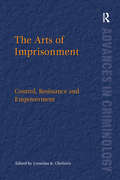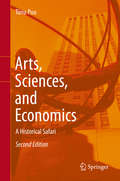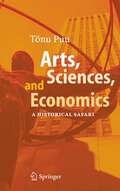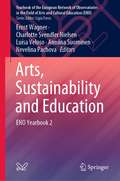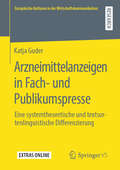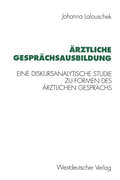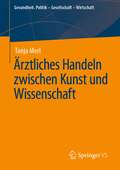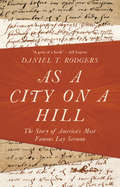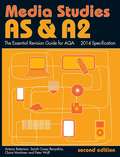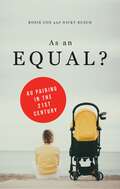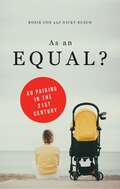- Table View
- List View
The Arts of Imprisonment: Control, Resistance and Empowerment (New Advances in Crime and Social Harm)
by Leonidas K. CheliotisThe arts - spanning the visual, design, performing, media, musical, and literary genres - constitute an alternative lens through which to understand state-sanctioned punishment and its place in public consciousness. Perhaps this is especially so in the case of imprisonment: its nature, its functions, and the ways in which these register in public perceptions and desires, have historically and to some extent inherently been intertwined with the arts. But the products of this intertwinement have by no means been constant or uniform. Indeed, just as exploring imprisonment and its public meanings through the lens of the arts may reveal hitherto obscured instances of social control within or outside prisons, so too it may uncover a rich and possibly inspirational archive of resistance to them. This edited collection sheds light both on state use of the arts for the purposes of controlling prisoners and the broader public, and the use made of the arts by prisoners and portions of the broader public as tools of resistance to penal states. The book also includes a number of chapters that address arts-in-prisons programmes, making distinctive contributions to the literature on their philosophy, formation, operation, effectiveness, and research evaluation, as well as taking care to explore the politics surrounding and underpinning these multiple themes.
The Arts of Imprisonment: Control, Resistance and Empowerment (New Advances in Crime and Social Harm)
by Leonidas K. CheliotisThe arts - spanning the visual, design, performing, media, musical, and literary genres - constitute an alternative lens through which to understand state-sanctioned punishment and its place in public consciousness. Perhaps this is especially so in the case of imprisonment: its nature, its functions, and the ways in which these register in public perceptions and desires, have historically and to some extent inherently been intertwined with the arts. But the products of this intertwinement have by no means been constant or uniform. Indeed, just as exploring imprisonment and its public meanings through the lens of the arts may reveal hitherto obscured instances of social control within or outside prisons, so too it may uncover a rich and possibly inspirational archive of resistance to them. This edited collection sheds light both on state use of the arts for the purposes of controlling prisoners and the broader public, and the use made of the arts by prisoners and portions of the broader public as tools of resistance to penal states. The book also includes a number of chapters that address arts-in-prisons programmes, making distinctive contributions to the literature on their philosophy, formation, operation, effectiveness, and research evaluation, as well as taking care to explore the politics surrounding and underpinning these multiple themes.
Arts of Subjectivity: A New Animism for the Post-Media Era
by Jacob W. GlazierBringing thinking from the arts and digital humanities into dialogue with one another, this book investigates what it means to be alive in a world that is structured by technology, the media, and an ever expanding sense of a global community. In this unique time in our history, when we are bombarded by signs and symbols and constantly connected into gadgets, apps, and networks, it has become increasingly difficult to navigate what has been dubbed a 'post-truth' world. Critiques taken from post-colonial studies and neoanimism help challenge the paranoia that has become endemic and, indeed, symptomatic to global realities we are now witnessing. This pertains not only to the ecological degradation of the planet but also to the lingering remnants of eurocentrism and racism that have taken the forms of nationalism and fascism. As a guide, an updated version of what Michel Foucault called an arts of existence may help us sail in these treacherous and confusing waters. Diving into post-structuralist French theory, through American feminism, and emerging out of media studies, this book argues for an ethical and aesthetic form of self-fashioning that runs counter to processes subjection and mediatization. This craft of life, as Plato called it, is a space of disjunction and liberation, between subjectivity and other, where something new and different has the potential to emerge and mould to our likeness.
Arts of Subjectivity: A New Animism for the Post-Media Era
by Jacob W. GlazierBringing thinking from the arts and digital humanities into dialogue with one another, this book investigates what it means to be alive in a world that is structured by technology, the media, and an ever expanding sense of a global community. In this unique time in our history, when we are bombarded by signs and symbols and constantly connected into gadgets, apps, and networks, it has become increasingly difficult to navigate what has been dubbed a 'post-truth' world. Critiques taken from post-colonial studies and neoanimism help challenge the paranoia that has become endemic and, indeed, symptomatic to global realities we are now witnessing. This pertains not only to the ecological degradation of the planet but also to the lingering remnants of eurocentrism and racism that have taken the forms of nationalism and fascism. As a guide, an updated version of what Michel Foucault called an arts of existence may help us sail in these treacherous and confusing waters. Diving into post-structuralist French theory, through American feminism, and emerging out of media studies, this book argues for an ethical and aesthetic form of self-fashioning that runs counter to processes subjection and mediatization. This craft of life, as Plato called it, is a space of disjunction and liberation, between subjectivity and other, where something new and different has the potential to emerge and mould to our likeness.
The Arts of Transitional Justice: Culture, Activism, and Memory after Atrocity (Springer Series in Transitional Justice #6)
by Olivera Simić Peter D. RushThe Art of Transitional Justice examines the relationship between transitional justice and the practices of art associated with it. Art, which includes theater, literature, photography, and film, has been integral to the understanding of the issues faced in situations of transitional justice as well as other issues arising out of conflict and mass atrocity. The chapters in this volume take up this understanding and its demands of transitional justice in situations in several countries: Afghanistan, Serbia, Srebenica, Rwanda, Northern Ireland, Cambodia, as well as the experiences of resulting diasporic communities. In doing so, it brings to bear the insights from scholars, civil society groups, and art practitioners, as well as interdisciplinary collaborations.
Arts Reviewing: A Practical Guide
by Andy PlaiceArts Reviewing: A Practical Guide is an accessible introduction to the world of arts criticism. Drawing on professional expertise and a range of cultural reviews from music, film, theatre, visual arts, television and books, Andy Plaice discusses different approaches to arts criticism, with tips on crafting great reviews. Chapters explore: • a brief history of arts criticism; • researching and preparing for an assignment; • legal and ethical boundaries when reviewing; • finding your own writing style; • starting and sustaining a career in arts criticism in the digital age. The book is underpinned by over 20 interviews with leading practitioners from across Britain, America and Australia. They offer fascinating insights into the life of a critic, including their best and worst career moments and the debates impacting the field of arts criticism. Interviewees include Neil McCormick, rock critic at the Daily Telegraph, the Guardian theatre critic Lyn Gardner and television critic Mark Lawson (BBC/ the Guardian). New approaches to reviewing techniques and writing style are combined with real-world advice from leading professionals in the field, making this book an ideal resource for students and graduates of journalism, cultural studies and media studies.
Arts Reviewing: A Practical Guide
by Andy PlaiceArts Reviewing: A Practical Guide is an accessible introduction to the world of arts criticism. Drawing on professional expertise and a range of cultural reviews from music, film, theatre, visual arts, television and books, Andy Plaice discusses different approaches to arts criticism, with tips on crafting great reviews. Chapters explore: • a brief history of arts criticism; • researching and preparing for an assignment; • legal and ethical boundaries when reviewing; • finding your own writing style; • starting and sustaining a career in arts criticism in the digital age. The book is underpinned by over 20 interviews with leading practitioners from across Britain, America and Australia. They offer fascinating insights into the life of a critic, including their best and worst career moments and the debates impacting the field of arts criticism. Interviewees include Neil McCormick, rock critic at the Daily Telegraph, the Guardian theatre critic Lyn Gardner and television critic Mark Lawson (BBC/ the Guardian). New approaches to reviewing techniques and writing style are combined with real-world advice from leading professionals in the field, making this book an ideal resource for students and graduates of journalism, cultural studies and media studies.
Arts, Sciences, and Economics: A Historical Safari
by Tönu PuuThis book deals with the economic aspects of changing attitudes in arts and sciences. The effects of the public good character of culture, along with the very long production period and lifetime for its products, are emphasized, since both contribute to the failure of normal market solutions. Embodiment of ideas and the consequences of modern reproduction technology for protection of property rights are closely examined.The evolution within arts and sciences, which often seems to return to previously scrapped ideals, is illustrated by detailed case studies, in which the importance of changing tastes, rather than progress proper, is emphasized.The author attempts an understanding for this using Darwinian evolution in combination with modern mathematical complexity theory, expressed in terms accessible to the general reader.The second edition is extended and updated especially as regards the illustration material.
Arts, Sciences, and Economics: A Historical Safari
by Tönu PuuThis book deals with the economic aspects of changing attitudes in arts and sciences. The effects of the public good character of culture, along with the very long production period and lifetime for its products, are emphasized, since both contribute to the failure of normal market solutions. Embodiment of ideas, and the consequences of modern reproduction technology for protection of property rights are closely examined.
Arts, Sustainability and Education: ENO Yearbook 2 (Yearbook of the European Network of Observatories in the Field of Arts and Cultural Education (ENO))
by Luísa Veloso Charlotte Svendler Nielsen Ernst Wagner Anniina Suominen Nevelina PachovaThis book explores the potential of arts and cultural education to contribute to on-going efforts to promote Education for Sustainable Development (ESD) in line with UNESCO’s conceptualizations of the field. It builds on the experiences of arts educators working to build sustainable futures and portrays new and innovative approaches. Chapters comprise case studies that combine arts, culture, sustainable thinking and practices. They also include research from historical perspectives, evaluations of public policy measures and offer theoretical approaches and methodologies. The book unfolds the possible relationships between arts and cultural education and Education for Sustainable Development.
Aryan and Non-Aryan in India (Michigan Papers On South And Southeast Asia #14)
by Madhav M. Deshpande Peter Edwin HookThe history and mechanisms of the convergence of ancient Aryan and non-Aryan cultures has been a subject of continuing fascination in many fields of Indology. The contributions to Aryan and Non-Aryan in India are the fruit of a conference on that topic held in December 1976 at the University of Michigan, Ann Arbor, under the auspices of the Center for South and Southeast Asian Studies. The express object of the conference was to examine the latest findings from a variety of disciplines as they relate to the formation and integration of a unified Indian culture from many disparate cultural and ethnic elements.
Arzneimittelanzeigen in Fach- und Publikumspresse: Eine systemtheoretische und textsortenlinguistische Differenzierung (Europäische Kulturen in der Wirtschaftskommunikation)
by Katja GuderKatja Guder untersucht Arzneimittelanzeigen hinsichtlich ihrer situativen Einordnung, ihres architektonischen Aufbaus, ihrer Funktion sowie sprachlichen Formulierungen und Vertextungsmustern. Arzneimittelanzeigen lassen sich hinsichtlich ihrer Bewerbung für medizinische Laien und dem medizinisch gebildeten Fachpublikum unterschiedlich charakterisieren, wodurch nicht nur ihre Einordnung in die Systemtheorie spezifiziert werden kann, sondern auch die Funktionen der einzelnen Anzeigenstrukturen für Laien- und Fachpublikum von einander differenziert betrachtet werden. Diese ganzheitliche Betrachtungsweise generiert für verschiedene Fachkreise (z.B. Werbeforschung, Sprachwissenschaft, Kommunikationswissenschaft, Medienwissenschaft u.a.) einen Mehrwert in der weiteren Forschung von pharmazeutischer Werbung sowie für Werbeanzeigen allgemein.
Ärzte oder Wunderheiler?: Die Macht der Medizin und der Mythos des Heilens
by Norbert SchmackeDie Ärzteschaft wurde im Laufe der letzen 100 Jahre zu einer einflußreichen Profession, die Gesunden wie Kranken in allen Lebenslagen beratend und behandelnd zur Verfügung steht. Die Leistungsfähigkeit der modernen Medizin hat nach dem Zweiten Weltkrieg in Quantensprüngen zugenommen. Und dennoch durchlebt die Ärzteschaft als Profession erneut eine schwere Krise. Die von ihr selbst geweckten Erwartungen kann sie bei drängenden Gesundheitsproblemen offenkundig nicht erfüllen: Es gibt kein Füllhorn, aus dem fortwährend Allheilmittel ausgeschüttet werden können. Umgekehrt haben sich in der Bevölkerung zum Teil unerfüllbare Vorstellungen von der Reichweite der Heilkunde entwickelt, denen weder die Ärzteschaft noch die große Schar alternativer Heiler seriös nachkommen kann. Das am meisten vernachlässigte Arzneimittel in der modernen Medizin ist die kompetente Kommunikation mit den Ratsuchenden und Patienten. Die Ärzteschaft muß sich erneut auf den Weg zu einer verständigen Medizin machen. Im Krankenhaus, in der Ambulanz und Prävention muß die Kompetenz der psychosozialen Fachberufe stärker als bisher genutzt werden. Eine Ärzteschaft, die sich von Allzuständigkeitsansprüchen lossagt und die Patientinnen und Patienten als Partner auf der Suche nach geeigneten Lösungen begreift, könnte den Weg aus der momentanen Krise weisen und die verengte gesundheitsökonomische Debatte aufbrechen. "(...) Ein spannendes, kenntnisreiches Buch für alle, die noch in der Lage sind, ihre Rolle in Frage zu stellen oder wissen wollen, wie es hinter der ärztlichen Fassade wirklich aussieht." Dr. med. Mabuse 108/97 "(...) Ein starkes, interessantes Buch, das die Krise unseres Gesundheitssystems intelligent analysiert und dabei auf keiner Seite langweilig ist. Der Wert des Buches wird durch die ausführliche kommentierte Bibliographie erhöht." Fachwissen für den Arzt, 10/97 "(...) Dieser aufschlußreichen, spannend zu lesenden und daneben auch relativ preiswerten Veröffentlichung ist ein gr
Ärztinnen für Frauen: Kliniken in Berlin 1877-1914. Ergebnisse der Frauenforschung, Band 39 (Ergebnisse der Frauenforschung)
by Kristin Renate HoeschÄrztliche Gesprächsausbildung: Eine diskursanalytische Studie zu Formen des ärztlichen Gesprächs
by Johanna LalouschekDiese diskursanalytische Studie zur Arzt-Patienten-Kommunikation untersucht zum einen den status quo ärztlichen Gesprächsverhaltens, zum anderen die Möglichkeiten und Probleme der Veränderung über Kommunikationstrainings. Die Analyse authentischer Gespräche im Krankenhaus zeigt, wie die ärztliche Gesprächspraxis im Rahmen einer somatisch orientierten Ausbildung üblicherweise erworben wird und welche institutionellen Funktionen sie erfüllt. In der anschließenden Analyse eines psychosozial orientierten Kommunikationstrainings werden vielfältige kommunikative Problemstellen deutlich, die in komplexer Weise mit Trainingskonzeption und schon internalisierter ärztlicher Gesprächspraxis zusammenhängen. Aufbauend auf den Ergebnissen werden diskursanalytisch fundierte Trainingsmodelle für Studium und Weiterbildung vorgestellt.
Ärztliche Verordnungspraktiken: Perspektiven am Beispiel der Diabetikerbehandlung
by Annette ReuterAnnette Reuter zeigt, wie sich die Versorgungsstrukturen des deutschen Gesundheitssystems durch die Zunahme chronischer Erkrankungen verändern. Am Beispiel der Versorgung von Typ-2-Diabetikern (T2D) erläutert sie die zurückliegenden ordnungspolitischen Aktivitäten und die entsprechenden Anpassungsleistung der deutschen Gesundheitsversorgung an die Bedürfnisse von T2D-Patienten. Grundlage ihrer Analyse sind Ereignisdaten (©Disease Analyzer, IMS Health Frankfurt a. M.) zu Patientenkonsultationen und ärztlichen Verordnungspraktiken in den Jahren 1993 bis 2009. Zudem führt sie verschiedene theoretische Ansätze in einem gemeinsamen Forschungsrahmen zusammen: Pfadabhängigkeit (Makroebene), institutionelle Feldlogiken (Mesoebene) sowie soziale Praktiken und Ressourcen (Mikroebene).
Ärztliche Werthaltungen gegenüber nichteinwilligungsfähigen Patienten: Ein Faktorieller Survey (Palliative Care und Forschung)
by Martin W. Schnell Christian Schulz Christiane Atzmüller Christine DungerDie Autoren untersuchen, mit welchen Werthaltungen Ärzte nichteinwilligungsfähigen Patienten begegnen und ob ihnen die gesetzliche Verankerung der Patientenverfügung und -rechte bei der Behandlung dieser vulnerablen Patienten Handlungssicherheit verleiht. Mithilfe des Faktoriellen Surveys können Einblicke in die ethischen Sicht- und Beurteilungsweisen von Ärzten gewonnen werden.
Ärztliches Handeln zwischen Kunst und Wissenschaft (Gesundheit. Politik - Gesellschaft - Wirtschaft)
by Tanja MerlAls vermeintlich selbstverständlicher Bestandteil der ärztlichen Tätigkeit ist die ‚ärztliche Kunst’ ein scheinbar vertrautes Phänomen, das im Alltagsverständnis auf allgemeine Akzeptanz stößt. Erst auf den zweiten Blick eröffnen sich Unklarheiten und Ambivalenzen. Eine substantielle Auseinandersetzung mit dem Begriff, seinen Implikationen und seines Stellenwerts - erst recht unter den gewandelten Bedingungen einer verwissenschaftlichten, technisierten und ökonomisierten Medizin - fehlt bislang. Durch die arbeitssoziologische Analyse können grundlegende Elemente der ‚ärztlichen Kunst’ empirisch präzisiert und handlungstheoretisch fundiert sowie ihre Bedeutung im Rahmen gegenwärtigen ärztlichen Handelns aufgezeigt werden.
As a City on a Hill: The Story of America's Most Famous Lay Sermon
by Daniel T. RodgersHow an obscure Puritan sermon came to be seen as a founding document of American identity and exceptionalism“For we must consider that we shall be as a city upon a hill,” John Winthrop warned his fellow Puritans at New England’s founding in 1630. More than three centuries later, Ronald Reagan remade that passage into a timeless celebration of American promise. How were Winthrop’s long-forgotten words reinvented as a central statement of American identity and exceptionalism? In As a City on a Hill, leading American intellectual historian Daniel Rodgers tells the surprising story of one of the most celebrated documents in the canon of the American idea. In doing so, he brings to life the ideas Winthrop’s text carried in its own time and the sharply different yearnings that have been attributed to it since.As a City on a Hill shows how much more malleable, more saturated with vulnerability, and less distinctly American Winthrop’s “Model of Christian Charity” was than the document that twentieth-century Americans invented. Across almost four centuries, Rodgers traces striking shifts in the meaning of Winthrop’s words—from Winthrop’s own anxious reckoning with the scrutiny of the world, through Abraham Lincoln’s haunting reference to this “almost chosen people,” to the “city on a hill” that African Americans hoped to construct in Liberia, to the era of Donald Trump.As a City on a Hill reveals the circuitous, unexpected ways Winthrop’s words came to lodge in American consciousness. At the same time, the book offers a probing reflection on how nationalism encourages the invention of “timeless” texts to straighten out the crooked realities of the past.
As a City on a Hill: The Story of America's Most Famous Lay Sermon
by Daniel T. RodgersHow an obscure Puritan sermon came to be seen as a founding document of American identity and exceptionalism“For we must consider that we shall be as a city upon a hill,” John Winthrop warned his fellow Puritans at New England’s founding in 1630. More than three centuries later, Ronald Reagan remade that passage into a timeless celebration of American promise. How were Winthrop’s long-forgotten words reinvented as a central statement of American identity and exceptionalism? In As a City on a Hill, leading American intellectual historian Daniel Rodgers tells the surprising story of one of the most celebrated documents in the canon of the American idea. In doing so, he brings to life the ideas Winthrop’s text carried in its own time and the sharply different yearnings that have been attributed to it since.As a City on a Hill shows how much more malleable, more saturated with vulnerability, and less distinctly American Winthrop’s “Model of Christian Charity” was than the document that twentieth-century Americans invented. Across almost four centuries, Rodgers traces striking shifts in the meaning of Winthrop’s words—from Winthrop’s own anxious reckoning with the scrutiny of the world, through Abraham Lincoln’s haunting reference to this “almost chosen people,” to the “city on a hill” that African Americans hoped to construct in Liberia, to the era of Donald Trump.As a City on a Hill reveals the circuitous, unexpected ways Winthrop’s words came to lodge in American consciousness. At the same time, the book offers a probing reflection on how nationalism encourages the invention of “timeless” texts to straighten out the crooked realities of the past.
AS & A2 Media Studies: The Essential Revision Guide For Aqa (Essentials)
by Antony Bateman Sarah Casey Benyahia Claire Mortimer Peter WallAS & A2 Media Studies: The Essential Revision Guide for AQA is a comprehensively updated new edition offering advice and guidance to help students pass AS and A2 Media Studies. Written by a team of experienced teachers and examiners, the book offers clear and engaging pathways through all the areas covered in the Media Studies curriculum, providing students with: • Revision Activities • Exam Tips and reminders • Definitions of key terms • Past paper questions • References to examiners reports. The authors also offer essential background information to help Media Studies students understand wider contexts and theoretical perspectives, as well as giving the lowdown on how exams are marked, how to manage self-study and approaching final examinations.
AS & A2 Media Studies: The Essential Revision Guide For Aqa (Essentials)
by Antony Bateman Sarah Casey Benyahia Claire Mortimer Peter WallAS & A2 Media Studies: The Essential Revision Guide for AQA is a comprehensively updated new edition offering advice and guidance to help students pass AS and A2 Media Studies. Written by a team of experienced teachers and examiners, the book offers clear and engaging pathways through all the areas covered in the Media Studies curriculum, providing students with: • Revision Activities • Exam Tips and reminders • Definitions of key terms • Past paper questions • References to examiners reports. The authors also offer essential background information to help Media Studies students understand wider contexts and theoretical perspectives, as well as giving the lowdown on how exams are marked, how to manage self-study and approaching final examinations.
As an Equal?: Au Pairing in the 21st Century
by Rosie Cox Nicky BuschAu pairs are relied upon by tens of thousands of UK families to do everything from childcare and housework to elder care, pet feeding and waiting at dinner parties. Traditionally thought of as privileged and well-educated young women having fun on a 'gap year' abroad, au pairs have been excluded from many of the recent discussions on migrant domestic labour. However, since 2008 au pairing has been effectively unregulated in the UK and the result is that au pairs now constitute one of the poorest paid and least protected groups of workers.Through an examination of lived experiences, As an Equal? draws on detailed research to examine au pairs and the families who host them in contemporary Britain, revealing au pairing to have become increasingly indistinguishable from other forms of domestic labour. Crucially, hosting an au pair is shown to form part of families' attempts to provide good (enough) childcare in the context of extended working hours and poor public childcare provision. This increased reliance of families on an exploited workforce is shown to form part of the wider political climate of economic austerity, and raises profound questions about the position of women within the neoliberal economy.
As an Equal?: Au Pairing in the 21st Century
by Rosie Cox Nicky BuschAu pairs are relied upon by tens of thousands of UK families to do everything from childcare and housework to elder care, pet feeding and waiting at dinner parties. Traditionally thought of as privileged and well-educated young women having fun on a 'gap year' abroad, au pairs have been excluded from many of the recent discussions on migrant domestic labour. However, since 2008 au pairing has been effectively unregulated in the UK and the result is that au pairs now constitute one of the poorest paid and least protected groups of workers.Through an examination of lived experiences, As an Equal? draws on detailed research to examine au pairs and the families who host them in contemporary Britain, revealing au pairing to have become increasingly indistinguishable from other forms of domestic labour. Crucially, hosting an au pair is shown to form part of families' attempts to provide good (enough) childcare in the context of extended working hours and poor public childcare provision. This increased reliance of families on an exploited workforce is shown to form part of the wider political climate of economic austerity, and raises profound questions about the position of women within the neoliberal economy.
As Far as the Eye can See: A History of Seeing
by S. Denham WadeEyes were one of the very first body parts to evolve more than 500 million years ago, and their structure has remained virtually unchanged through most of evolutionary history. But eyes alone were never enough for Homo sapiens. From the mastery of fire a million years ago to the smartphone today, humans have repeatedly invented new ways to see their surroundings, each other and themselves. Artificial light, art, mirrors, writing, lenses, printing, photography, film, television, smartphones – these tools didn’t just add to our visual repertoire, they shaped cultures around the world and made us who we are. Drawing on sources from anthropology to zoology, neuroscience to Netflix, As Far As the Eye Can See traces the history of seeing from the first evolutionary stirrings of sight and discovers that each time we changed how or what we see, we changed ourselves and the world around us. Along the way, it finds, sight slowly eclipsed our other senses. Are we now at ‘peak seeing’, the author asks. Can our eyes keep up with technology? Have we gone as far as the eye can see?
